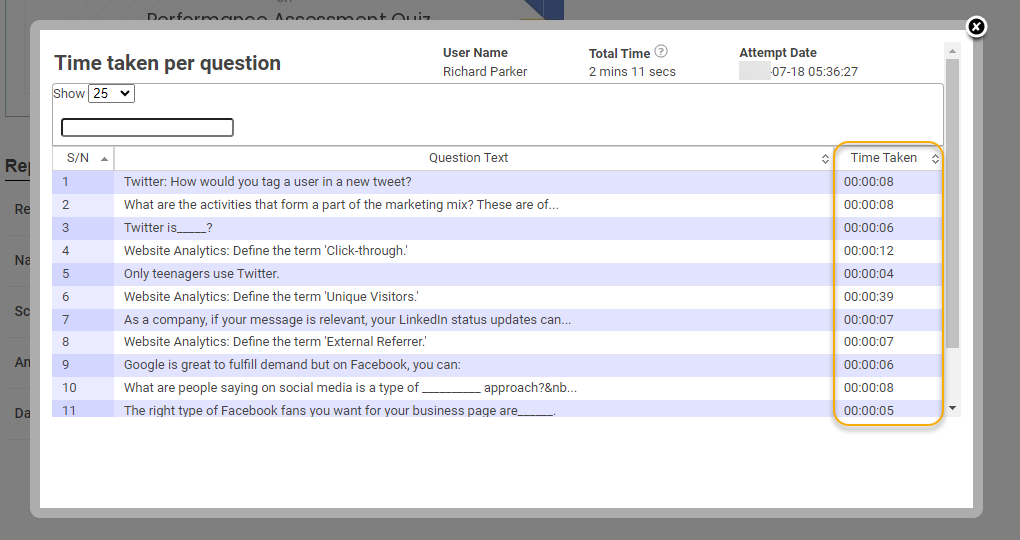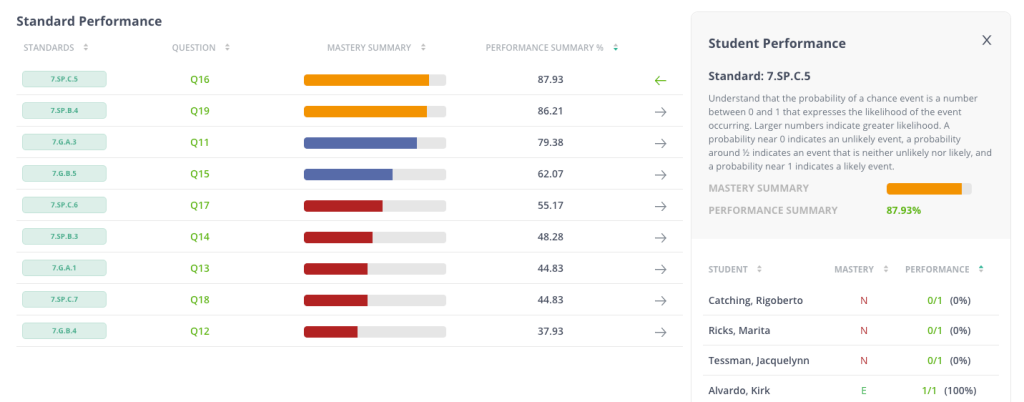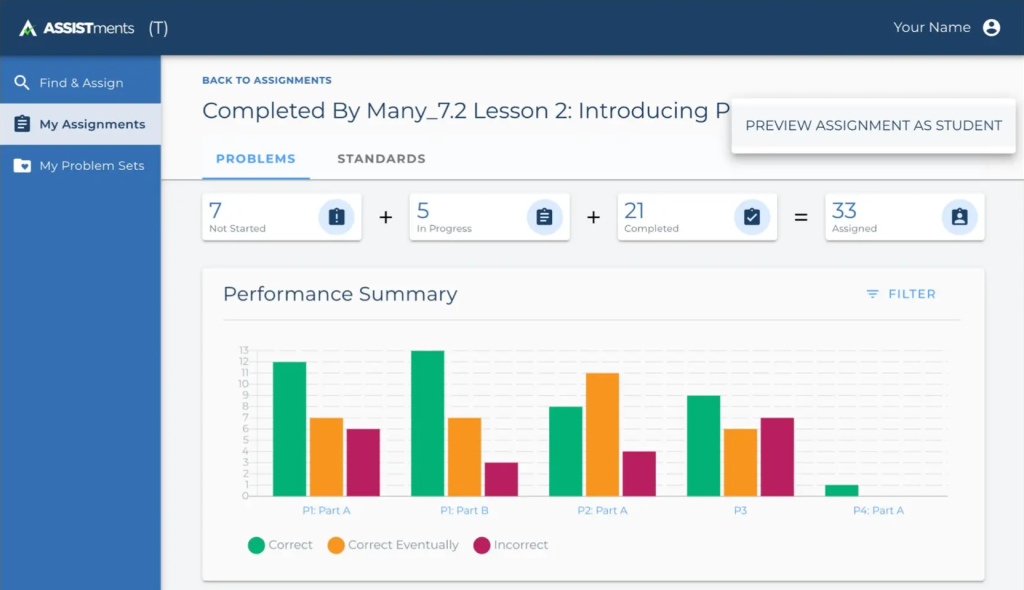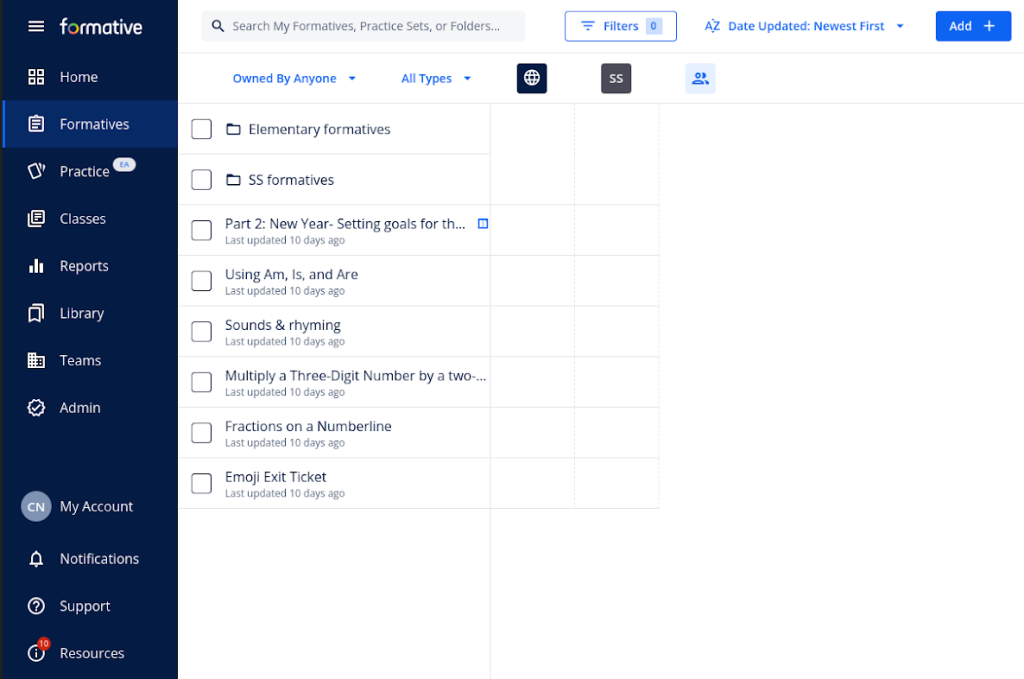Checking for understanding is beneficial for both students and teachers. We’ve compiled a list of various formative assessment tools to assist you in this process.
Formative assessment tools are essential for teachers and trainers aiming to build effective learning environments. But I’ve witnessed how challenging it can be to identify where each learner stands in their understanding—especially in a diverse setting where everyone learns differently.
The right formative assessment tools provide clear, actionable data that reveals what students grasp and where they may need support. Once the knowledge levels are assessed, instructors can adapt their instruction and curriculum to address specific gaps.
With that in mind, in this article, I’ve compiled 20 of the best formative assessment tools that can help educators and learners alike keep learning on track. Here’s a quick look at them:
| Formative Assessment Tool | Best For | Pricing Details |
| ProProfs Quiz Maker | Creating secure quizzes with AI or templates | Forever FREE for short quizzes and all essential features. Paid plans start at $19.99/month. |
| Pear Assessment | Standards-aligned assessments with real-time insights | Free plan available; paid plans start at $125/year. |
| ASSISTments | Supporting math skills with instant feedback | Free basic plan; custom pricing for advanced features. |
| Formative | Real-time, interactive formative assessments | Free plan available; paid plans start at $12/month. |
| Kahoot! | Gamifying quizzes to boost engagement | Free plan available; paid plans start at $10/host/month. |
| Gimkit | Interactive, strategy-based quiz games | Starts at $650/year for 20 teachers. |
| Plickers | Quick, no-device classroom polling | Free plan available; paid plans start at $5.99/month. |
| Google Forms | Basic quiz and survey creation | Free with a Google account; Google Workspace plans start at $6/user/month. |
| Mentimeter | Real-time polls and audience interaction | Free plan available; paid plans start at $8.99/presenter/month for educators. |
| Wooclap | Engaging students with interactive polls and quizzes | Free plan available; paid plans start at $10.99/user/month. |
| Quizlet | Educational quizzes | Free plan available; paid plan starts at $68.38/year. |
| Quizizz | Real-time insights | Free plan available; custom pricing for educational use. |
| Edpuzzle | Embedding formative questions in video lessons | Free plan available; paid plans start at $13.50/month. |
| PlayPosit | Interactive video lessons | Custom pricing |
| Padlet | Collaborative, visual brainstorming and feedback | Free plan available; paid plans start at ₹99/month. |
| Nearpod | Interactive, multimedia-rich lessons | Free plan available; paid plans start at $159/year. |
| Pear Deck | Adding interactive elements to Google Slides | Free plan available; paid plans start at $149/year for educators. |
| LessonUp | Creating interactive lessons with adaptive pathways | Free plan available; paid plans start at $6/month. |
| InsertLearning | Annotating web content with embedded questions | Free plan available; paid plans start at $19.99/month. |
| Explain Everything | Real-time collaborative whiteboarding | Free plan available; paid plans start at $34.99/year. |
What Is Formative Assessments?
A formative assessment is often referred to as an “assessment for learning.” These are the assessments that the instructors use in the first phase of developing learning material and instructions for the learners.
The aim of conducting formative assessments is to measure the level of knowledge before the learning process begins. In simple words, it’s to identify:
- Those who’re struggling with instructions, and
- The areas where they are struggling
Measuring knowledge would differ based on different types of formative assessments out there. Speaking of types, here are some of the most common examples of formative assessment tools for teachers and trainers:
- Quizzes
- Polls
- Observation
- Worksheets
- Diagnostic tests
My Top 3 Picks for the Best Formative Assessment Tools
If you’re short on time and need a quick recommendation, here are three formative assessment tools that stand above the rest:
- ProProfs Quiz Maker
ProProfs Quiz Maker streamlines quiz creation with its AI-powered question generator and a vast question library, making it ideal for quick, reliable assessments. Automated grading and detailed analytics provide immediate insights, allowing instructors to spot knowledge gaps and make adjustments on the go. Security features like password protection and proctoring add an extra layer of integrity to assessments, making ProProfs a practical choice.
- Quizizz
Quizizz energizes the classroom with its game-like quizzes and instant feedback. The tool’s “Team Mode” supports collaboration, and varied question types add a fun, engaging element. Real-time analytics reveal student comprehension at a glance, allowing for swift instructional tweaks. With easy integration into platforms like Google Classroom, Quizizz is a flexible choice for educators seeking a balance of engagement and insights.
- Nearpod
Nearpod combines quizzes, polls, and even virtual reality with a library of standards-aligned lessons. Its “Differentiated Lessons” feature customizes learning based on individual needs, while live insights keep instructors informed on student progress. Nearpod’s seamless compatibility with Google Slides and other tools makes it a valuable option for those looking to create immersive, adaptable lessons that effectively support and assess student learning.
List of Formative Assessment Tools for Teachers & Trainers
This list of tools is curated based on personal experience, insights from peers, and customer feedback on reputable review platforms.
Quiz and Assessment Tools
1. ProProfs Quiz Maker – Best for Easily Creating Secure Quizzes With AI or Templates
ProProfs Quiz Maker streamlines the process of creating interactive, learning-oriented quizzes. With automated grading and instant feedback, learners can quickly understand their strengths and areas for improvement. What I find especially compelling is the AI quiz generator, which allows instructors to instantly generate questions and answer explanations on any topic with just a few clicks.
Instructors can also import questions from ProProfs’ library of over 1 million questions or bulk upload them from spreadsheets and doc files. The platform offers in-depth reporting and analytics tools that provide insights into individual and group performance, helping instructors pinpoint trends and learning gaps efficiently.

To ensure the security and integrity of assessments, ProProfs includes features like password protection, proctoring, tab-switching prevention, question randomization, time limits, and more. With multimedia support, 20+ question types, and virtual classroom functionalities, ProProfs adapts well to diverse instructional styles, offering a versatile and reliable tool for ongoing assessment.
What You’ll Like:
- Option to analyze response time per question, offering insights into question difficulty and learner confidence.
- Advanced analytics track performance over time, allowing instructors to monitor improvement and retention rates.
- Automated feedback options: provide specific feedback for correct or incorrect answers or a general explanation.
- Add manual feedback in text, video, or audio format in the quiz reports to provide personalized guidance.
- Customizable notifications allow instructors to remind learners about upcoming quizzes or assignment deadlines.
- What You May Not Like:
- The tool is only available online; no offline or on-premise versions are offered.
- Some users may miss having a dark mode option.
Pricing:
Forever FREE for short quizzes and all essential features. Paid plans start at $19.99/month.
2. Pear Assessment (Formerly Edulastic) – Best for Standards-Aligned Assessments With Real-Time Insights

Image source: peardeck.com
When I explored Pear Assessment, I was impressed by its comprehensive approach to educational assessments. This formative assessment tool offers a vast library of standards-aligned questions, allowing me to create customized assessments tailored to my curriculum.
The real-time data analytics provided immediate insights into student performance, enabling me to identify learning gaps and adjust instruction accordingly. Additionally, the integration with various educational tools streamlined the assessment process, making it more efficient and user-friendly.
The ability to administer both formative and summative assessments within the same platform adds to its versatility, catering to diverse educational needs. Overall, Pear Assessment is a valuable resource for enhancing the assessment experience in educational settings.
What You’ll Like:
- Allows easy differentiation for students by adjusting questions based on ability levels.
- Offers customizable rubrics that can help tailor assessments to specific grading criteria.
- Integrates with Google Classroom for seamless assignment distribution and tracking.
- Provides interactive question types, including drag-and-drop and hotspot, for increased engagement.
What You May Not Like:
- Some users have reported a steep learning curve when initially navigating the platform’s features.
- Occasional technical glitches have been noted, particularly during peak usage times.
Pricing:
A free plan is available for educators; paid plans start at $125/year.
3. ASSISTments – Best for Supporting Math Skills With Instant Feedback

Image source: new.assistments.org
ASSISTments provides a fresh approach to math learning by combining instant feedback with adaptable content. Exploring its features, I noticed how each problem set aligns with curriculum standards, making every exercise purposeful.
The instant feedback engages students directly with their mistakes, encouraging them to think critically as they work through problems. The platform’s reporting is impressively detailed, provides a direct view into each learner’s progress, and helps pinpoint areas where support is needed.
Integration with other platforms keeps things organized and easy to manage. ASSISTments feels more like a learning partner than a traditional tool, connecting learning goals to actionable insights that bring math practice to life.
What You’ll Like:
- Offers a vast library of math problems, including content from well-known textbooks and open resources.
- Allows flexibility in problem sets, letting you adjust assignments to suit different learning needs.
- Features interactive question types that keep students engaged beyond traditional problem formats.
- Supports targeted instruction by highlighting specific misconceptions that students may encounter.
What You May Not Like:
- Performance can slow down slightly when working with larger classes or more detailed assignments, which may affect workflow during peak usage times.
- It’s only suitable for math assessments.
Pricing:
Free basic plan; custom pricing for the school and district solution with advanced features.
4. Formative – Best for Real-Time, Interactive Formative Assessments

Formative creates an engaging space for real-time assessment, letting educators view student responses as they happen. I was intrigued by its variety in question types—multiple-choice, short answers, drawings—that add a new level of interactivity.
Watching responses populate instantly brings a sense of immediacy so feedback can be timely and tailored. The analytics also stood out, revealing nuanced trends across assignments that make it easy to identify recurring challenges or strengths over time.
Integrating with different LMS platforms, this digital formative assessment tool keeps assignments organized so that everything stays accessible. With Formative, assessments feel more like an adaptive dialogue, adjusting to meet students where they are.
What You’ll Like:
- Lets you add hints to questions, supporting students without revealing answers directly.
- Provides student portfolios that organize responses by the individual, allowing deeper insight into progress.
- Includes a “Show Your Work” feature, encouraging students to visually map out problem-solving steps.
- Offers self-grading options for certain question types, saving time while still allowing in-depth feedback.
What You May Not Like:
- Some users have noted that customizing reports can be limited, which may affect personalized data tracking.
- The collaborative features are somewhat basic, with limited options for student-to-student interaction within the tool.
Pricing:
A free plan is available (basic features only); paid plans start at $12/month.
5. Kahoot – Best for Gamifying Quizzes to Boost Engagement
Image source: kahoot.com
Kahoot! transforms traditional quizzes into interactive games, making learning both fun and engaging. I was impressed by how easy it is to create custom quizzes, known as “kahoots,” that incorporate multimedia elements like images and videos.
The platform supports live games, where participants join via a unique PIN, fostering a competitive yet educational environment. Additionally, Kahoot! offers self-paced challenges, allowing learners to participate asynchronously, which is particularly useful for homework or remote learning scenarios.
The real-time feedback and leaderboard features motivate participants to perform better, enhancing the overall learning experience. Kahoot! effectively combines education with entertainment, making it a valuable tool for educators and trainers aiming to increase engagement.
What You’ll Like:
- Access to a vast library of ready-to-play games across various subjects and topics
- Integration with video conferencing tools, enabling seamless virtual game sessions
- Detailed analytics and reports to track participant performance and identify knowledge gaps
- Customizable game templates to streamline the quiz creation process
What You May Not Like:
- Occasional technical issues, such as lag during live games, have been noted, particularly with larger groups.
- Some users feel the scoring system doesn’t reflect question difficulty, which can affect fairness in competitive play.
Pricing:
Starts at $10/host/month for basic features and up to 20 participants per session.
6. Gimkit – Best for Interactive, Strategy-Based Quiz Games
Image source: gimkitblog.squarespace.com
Gimkit merges academics with gaming strategy, offering quizzes with a fresh twist that feels like play. There’s something intriguing about how students earn virtual money for each correct answer, which they can later spend on upgrades and power-ups—adding a layer of strategy to learning.
Watching this in action, I noticed that students get to decide when to use their “earnings” for an edge, making them actively invested in each question. Modes like “Trust No One” and “Fishtopia” mix things up, turning standard quizzes into interactive challenges.
Real-time feedback lets educators see progress immediately, making adjustments easy. This online formative assessment tool combines strategy with academics, creating an experience that holds students’ attention through learning and play.
What You’ll Like:
- Unique game modes provide fresh experiences and keep students interested.
- Team-based options encourage collaboration and peer interaction.
- Built-in question bank simplifies quiz creation for educators.
- The self-paced mode supports individual learning preferences and flexibility.
What You May Not Like:
- Limited pacing control can reduce opportunities to pause for explanations.
- Some students may prioritize in-game rewards over mastering content.
Pricing:
Starts at $650/year for 20 teachers.
7. Plickers – Best for Quick, No-Device Classroom Polling
Image source: help.plickers.com
Plickers offers an effective way to run quick assessments without student devices. I found the concept refreshingly simple: each student holds a unique, printable card that they rotate to indicate their answer while I scan the room with my smartphone or tablet to capture responses instantly.
This setup provides quick feedback on student comprehension without needing screens, which cuts down on distractions. The offline functionality is a plus, allowing for reliable use even when internet access is spotty.
Plickers creates an efficient polling option that fits seamlessly into varied classroom settings, providing a fast and distraction-free way to gauge understanding.
What You’ll Like:
- Requires no student devices, minimizing distractions in the classroom.
- Captures and analyzes data instantly, supporting timely adjustments.
- User-friendly interface makes question setup quick and straightforward.
- Works offline, which is great for tech-limited classrooms or unreliable internet.
What You May Not Like:
- Scanning may be inconsistent in larger classes, sometimes needing multiple attempts.
- Physical cards can get lost or damaged, requiring periodic replacements.
Pricing:
Starts at $5.99/month.
8. Google Forms – Best Free Form Maker for Basic Quiz & Survey Creation
Image source: Google Forms
Google Forms is a versatile tool that allows users to create surveys, quizzes, and forms with ease. Its intuitive interface enables quick setup, and the integration with other Google Workspace apps enhances functionality.
I appreciate the variety of question types available, such as multiple-choice, checkboxes, and short answers, which cater to diverse data collection needs. The real-time response tracking and automatic data organization into Google Sheets streamline the analysis process.
Additionally, the ability to customize themes and add images or videos makes the forms more engaging. Overall, this digital formative assessment tool offers a user-friendly and efficient solution for creating basic quizzes and surveys without any cost.
What You’ll Like:
- Form templates for quizzes, assessments, exit tickets, and course feedback
- Seamless integration with Google Workspace enhances productivity.
- Real-time response tracking allows for immediate data analysis.
- Customizable themes and multimedia support increase engagement.
- Automatic data organization into Google Sheets simplifies management.
What You May Not Like:
- The lack of advanced question types can limit the complexity of quizzes.
- There’s no option for implementing conditional logic in the free version of the tool.
Pricing:
Google Forms is free with a Google account; Google Workspace plans with extra features start at $6 per user/month.
9. Mentimeter – Best for Real-Time Polls and Audience Interaction
Image source: educatorsquest.com
Mentimeter brings presentations to life by making audience participation central. Responses appear instantly on the screen, which creates an energy in the room that’s hard to achieve with traditional slides.
Participants join through their devices to answer polls, take quizzes, or ask questions, all in real time. The diverse response formats—word clouds, scales, multiple-choice—gives presenters flexibility to suit any setting or goal, adapting effortlessly to different presentation needs.
Integrating with other tools is straightforward, so it fits naturally into existing workflows. For anyone wanting more engagement in sessions, Mentimeter offers a lively, responsive way to connect with the audience and spark interaction.
What You’ll Like:
- User-friendly interface that simplifies the creation of interactive slides.
- Supports anonymous responses, encouraging open and honest feedback.
- Provides real-time data visualization for easy, immediate analysis.
- Offers a broad range of question types to fit different interaction needs.
What You May Not Like:
- The character limit for questions and responses can be restrictive for topics needing more in-depth answers.
- Poll results may load with a slight delay in larger groups, which can impact the flow of live presentations.
Pricing:
A free plan is available (50 participants per month); paid plans start at $8.99/presenter/month for teachers and $11.99/presenter/month for others.
10. Wooclap – Best for Engaging Students With Interactive Polls and Quizzes
Image source: wooclap.com
Wooclap offers a way to add energy to lessons by using live polls, quizzes, and various question formats to engage students directly. Watching students answer instantly from their devices—whether they’re in class or remote—really changes the feel of a session.
The integration with PowerPoint and Google Slides is practical, as it allows interactive elements to blend into existing slides, keeping the lesson flow smooth. I like that Wooclap doesn’t just work in live settings; it’s versatile enough to use for self-paced activities too, adapting easily to different classroom setups.
For educators looking for an interactive boost, Wooclap brings in just the right balance of simplicity and engagement, making it a great tool for real-time feedback and involvement.
What You’ll Like:
- Offers multiple question types that enable a broader range of creative ways to engage students.
- Real-time analytics provide a quick, accessible insight into student comprehension and understanding.
- Anonymous responses foster a safe environment, encouraging more genuine and honest feedback.
- Simple integration with common tools like PowerPoint, Google Slides, and Zoom saves time on setup and keeps presentations seamless.
What You May Not Like:
- Some users report issues with Wooclap’s PowerPoint integration, preferring to use Wooclap separately for more reliable performance.
- Wooclap’s question types offer limited customization, lacking options for design, branching, and adaptive assessments.
Pricing:
A free plan is available (only 2 questions per event); paid plans start at $10.99/user/month.
11. Quizlet – Best for Educational Quizzes
Image source: Pinterest
Quizlet offers a flexible approach to formative assessment, extending far beyond traditional quizzes. It provides access to an extensive library of study sets across diverse subjects like languages, history, science, and math, making this formative assessment tool a versatile resource for students and educators alike.
One thing I appreciate is the option to create custom flashcards and quizzes, allowing users to tailor content to their specific needs. Quizlet also features multiple study modes, including engaging games like “Match” and “Gravity,” which make review sessions feel like play.
Its “Learn” mode, with adaptive feedback and spaced repetition, helps reinforce material over time, enhancing retention and mastery.
What You’ll Like:
- Seven distinct study modes—flashcards, learn, spell, test, match, gravity, and live—support different learning preferences.
- Access to a massive database of over 500 million study sets created by other students and educators.
- Adaptive learning technology tracks progress and adjusts question difficulty for optimal learning.
- Enables collaboration through study groups and shared flashcard sets for collective learning.
What You May Not Like:
- User-generated content quality varies, so study materials may differ in accuracy and depth.
- Limited support for subjects requiring critical thinking, analysis, or hands-on application.
Pricing:
Free plan available (limited features); paid plan starts at $68.38/year.
12. Quizizz – Best for Real-Time Insights
Image source: support.quizizz.com
With Quizizz, educators can create dynamic quizzes, lessons, and activities tailored for formative assessment. The real-time insights feature is especially valuable, providing instant feedback on student comprehension and enabling teachers to adjust instruction as needed. This makes it easy to spot knowledge gaps and track individual progress.
Beyond standard quizzes, this online formative assessment tool offers tools like interactive polls and “Team Mode,” where students collaborate in groups, encouraging discussion, reflection, and active participation.
With options for polls, open-ended questions, and multimedia elements, Quizizz transforms traditional assessments into interactive learning sessions that keep students engaged. It integrates smoothly with platforms such as Google Classroom, Edmodo, and Remind.
What You’ll Like:
- Smart proctoring helps maintain assessment integrity by minimizing opportunities for cheating.
- Gamification features—like music, memes, and leaderboards—make quizzes lively and enjoyable.
- Accessible on any device, with no need for students to create accounts.
- A library of pre-made quizzes on various subjects saves time for quick setup or customization.
What You May Not Like:
- Customer support is limited to email, Twitter, and support tickets.
- The interface can be challenging to navigate, and some users report difficulties with test-running quizzes or generating access codes.
Pricing: Starts at $3/learner/month for businesses; custom pricing for educational use
Interactive and Collaborative Learning Tools
13. Edpuzzle – Best for Embedding Formative Questions in Video Lessons
Image source: timetotalktech.com
Edpuzzle lets instructors transform standard videos into interactive learning experiences by embedding questions within the video timeline. This setup allows learners to engage with content more actively, answering questions as they watch, which promotes better retention and focus.
I like how Edpuzzle’s real-time analytics make it easy to track learner responses, highlighting areas that may need further review. Instructors can choose from multiple question formats suiting various assessment needs.
Edpuzzle also integrates with popular learning management systems, making it simple to assign and monitor video lessons across classes. For those short on time, Edpuzzle’s library of ready-made video lessons is a valuable resource for immediate use.
What You’ll Like:
- Ability to set due dates and monitor completion to keep learners on track
- Access to a library of community-shared video lessons for quick, customizable options
- Skipping prevention ensures learners stay engaged and complete the full video.
- Voiceover and audio note options enable instructors to personalize video instruction.
- Google Classroom integration streamlines lesson distribution and feedback.
What You May Not Like:
- Limited video editing tools may restrict customization for some content.
- Limited interactive features beyond basic questions may restrict deeper engagement in certain subjects.
Pricing:
Starts at $13.50/month.
14. PlayPosit – Best for Interactive Video Lessons
Image source: knowledge.playposit.com
PlayPosit allows educators to transform video content into a highly interactive experience. Instructors can embed various interactive elements within videos, including multiple-choice questions, discussions, polls, and even fill-in-the-blank activities, encouraging active learning and helping to boost retention.
I find the option to add voiceovers or audio notes particularly useful. This personalizes the lesson and offers further explanation on complex topics. This formative assessment tool also integrates with many learning management systems, simplifying assignment and tracking.
Additionally, instructors can access a shared library of interactive videos, offering a time-saving resource for lesson preparation and a way to explore new ideas.
What You’ll Like:
- Prevents skipping, ensuring learners engage fully with video content.
- Voiceover and audio note options allow for personalized instruction.
- Due dates and completion tracking help keep learners on schedule.
- Access to a library of customizable interactive video lessons shared by other educators.
What You May Not Like:
- Some users may find the interface complex due to the wide range of features.
- Occasional issues with video playback and buffering can disrupt the learning experience.
Pricing:
Custom quote available on request.
15. Padlet – Best for Collaborative, Visual Brainstorming and Feedback
Image source: padlet.com
Padlet makes collaborative brainstorming easy by providing an interactive canvas where users can post ideas, comments, and media in real time. I was impressed by how customizable the boards are, allowing for different layouts and themes to fit any project’s needs.
Supporting file types like images, videos, links, and documents, Padlet makes it possible to add depth to collaborative projects by integrating multimedia. It’s versatile enough for both classroom and professional use, with privacy settings that allow creators to control who can view or edit the boards.
Beyond individual projects, Padlet’s integration with tools like Google Classroom and Microsoft Teams streamlines its use in educational settings. For instructors and team leaders, real-time updates and feedback features make it easier to track contributions and engagement.
What You’ll Like:
- User-friendly interface with a minimal learning curve for beginners
- Rich multimedia support, accommodating text, images, videos, and more
- Adjustable privacy settings to manage board access and control
- Templates and examples that provide creative inspiration for new users
What You May Not Like:
- You may experience lag and slower loading times when boards contain extensive multimedia content.
- Customization options for font styles and board aesthetics are somewhat limited.
Pricing:
A free plan is available (max. 3 boards and basic features); paid plans start at ₹99 /month.
16. Nearpod – Best for Interactive, Multimedia-Rich Lessons
Image source: Nearpod.com
Nearpod brings an engaging approach to formative assessment, blending interactive elements like quizzes, polls, and even virtual reality into lesson content. I like how it lets learners answer questions mid-lesson, offering instructors real-time insights and enabling instant course corrections when needed.
Nearpod’s vast library of over 22,000 standards-aligned lessons means you don’t have to start from scratch every time—there’s already a foundation to build on and customize. Integrating smoothly with Google Slides and Microsoft Teams, it fits easily into your existing workflows, letting you pull in familiar resources while adding Nearpod’s interactive touch.
Whether you’re leading a live session or setting up a self-paced activity, this formative assessment tool adapts to different teaching needs.
What You’ll Like:
- Provides the option to assign differentiated lessons based on learner readiness.
- Includes interactive drawing tools that let students visually demonstrate their understanding.
- Offers post-session reports for detailed breakdowns of learner performance.
- Allows educators to add interactive “checkpoints” at any point in the lesson for deeper assessment.
What You May Not Like:
- Customizing interactive elements like polls or quizzes is somewhat restricted, which can limit tailored feedback.
- Virtual reality elements may not work consistently across all student devices, impacting the experience for some learners.
Pricing:
A free plan is available (limited features and 100mb storage). Paid plans start at $159/year.
17. Pear Deck – Best for Adding Interactive Elements to Google Slides
Image source: peardeck.com
Designed to make Google Slides more engaging, Pear Deck enables instructors to embed formative assessments directly within presentations, turning passive slides into interactive experiences. Learners can respond to polls, questions, and draggable prompts in real time, allowing instructors to assess understanding instantly and make adjustments on the spot.
What I find especially useful is Pear Deck’s seamless integration with Google Classroom, which makes it easy to assign, collect, and track responses, simplifying the workflow for educators.
With a range of question types—from multiple-choice to open-ended formats—Pear Deck supports varied instructional needs. The platform’s user-friendly setup and resource library make it accessible, providing even first-time users with ideas and templates for interactive, student-centered lessons.
What You’ll Like:
- Ready-made interactive templates save setup time and spark creative ideas.
- Customizable response visibility settings create a safe space for honest feedback.
- The Reflect & Review feature allows students to revisit answers, reinforcing learning after class.
- Background audio options let teachers add guidance or explanations to help students navigate content independently.
What You May Not Like:
- Limited customization options for interactive elements may feel restrictive for advanced users.
- The platform’s integration with non-Google tools is quite limited.
Pricing:
A free plan is available (no advanced features). Paid plans start at $149/year for educators.
18. LessonUp – Best for Creating Interactive Lessons With Adaptive Question Pathways
Image source: support.academicsoftware.eu
Designed to foster engagement and differentiation, LessonUp lets educators create interactive lessons that respond to student needs. Through tools like drag-and-drop questions, polls, and quizzes, instructors can build lessons that adjust based on student responses, providing a more customized learning path.
I find the adaptive question pathways particularly helpful for personalizing instruction. They allow learners to receive different question sequences or resources depending on their answers. With built-in analytics, LessonUp offers insights into student progress and understanding, helping educators make data-driven decisions.
Multimedia support makes embedding videos, images, and audio easy, thereby enhancing the lesson experience and keeping students engaged.
What You’ll Like:
- Access to a vast library of ready-made lessons that can be customized to fit your teaching style.
- Integration with popular LMS platforms, streamlining the assignment and tracking of lessons.
- Ability to incorporate real-time feedback mechanisms, enhancing student engagement.
- Support for collaborative learning through features that enable group activities and discussions.
What You May Not Like:
- Basic analytics; lacks deeper insights for tracking long-term student progress
- Limited options for real-time student collaboration during lessons
Pricing:
Starts at $6/month.
19. InsertLearning – Best for Annotating Web Content with Embedded Questions
Image source: InsertLearning
InsertLearning is a Chrome extension that enables educators to transform any webpage into an interactive lesson. By adding annotations, questions, and discussions directly onto web content, it facilitates active reading and engagement.
Teachers can highlight text, insert sticky notes, and embed questions to assess comprehension in real time. This tool supports various question types, including multiple-choice and open-ended formats, allowing for diverse assessment methods.
Additionally, this formative assessment tool integrates with Google Classroom, streamlining the assignment and grading process. Its user-friendly interface and versatility make it a valuable resource for enhancing digital literacy and critical thinking skills among students.
What You’ll Like:
- Enables embedding of multimedia content, such as videos and images, to enrich lessons.
- Allows for real-time monitoring of student annotations and responses, facilitating immediate feedback.
- Supports collaborative discussions directly on the webpage, promoting peer interaction.
- Offers a library of pre-made lessons and resources for quick implementation.
What You May Not Like:
- Limited analytics make it challenging for teachers to track student engagement and progress over time.
- Some users find that the annotation tools are somewhat basic, lacking advanced features for detailed feedback.
Pricing:
A free plan is available (2 lessons); paid plans start at $19.99/month.
20. Explain Everything – Best for Real-Time Collaborative Whiteboarding
Image source: hybridmedia.io
Explain Everything serves as a highly interactive digital whiteboard that’s perfect for both collaborative and multimedia-driven instruction. I was impressed by its range of tools, allowing instructors to create, annotate, and record engaging lessons.
The platform supports images, videos, and even live document annotations, letting educators design content-rich, interactive sessions tailored to various learning styles. Explain Everything’s real-time collaboration feature also enables students to work together on projects or follow along during live instruction, making it a flexible option for both in-person and remote classrooms.
Plus, the integration with cloud storage platforms like Google Drive and Dropbox streamlines file sharing, keeping resources easily accessible.
What You’ll Like:
- Real-time collaboration supports interactive group work and engagement.
- Variety of annotation tools, from drawing to text, for detailed explanations.
- Seamless cloud integration with Google Drive and Dropbox for easy file access.
- Offers screen recording and export options, ideal for creating reusable lesson videos.
What You May Not Like:
- Syncing projects across devices isn’t always seamless.
- Some users find the interface cluttered, making it challenging to quickly locate specific tools.
Pricing:
A free plan is available (up to 3 projects); paid plans start at $34.99/year.
Our Evaluation Criteria: How We Selected the Best Formative Assessment Tools
The formative assessment tools featured in this article were chosen through a rigorous and systematic review process that emphasizes their effectiveness in supporting learning and instruction. We focused on six key criteria:
- User reviews and ratings: Feedback from educators, students, and reputable review sites provided insights into the overall user satisfaction and common challenges of each tool. This input is essential for understanding both strengths and areas for improvement.
- Essential features and functionality: We assessed each tool’s core features, particularly those related to formative assessment, such as real-time feedback, adaptive learning options, and multimedia integration. This reveals how effectively each tool aids in monitoring and supporting student progress.
- Ease of use: The user experience was evaluated for simplicity and intuitiveness, with a focus on the tool’s layout, navigation, and accessibility. User-friendly tools are critical for enhancing the experience for both instructors and learners.
- Customer support: We looked into the quality of customer support provided, including the responsiveness and availability of help resources. Quick and reliable support is important for smooth onboarding and troubleshooting.
- Value for money: Each tool was assessed based on its pricing in relation to the quality of features and the depth of formative assessment capabilities. This helps readers understand whether the tool is a worthy investment for their educational needs.
- Personal experience and expert insights: This evaluation draws from hands-on experience with these tools, as well as insights from educators and industry experts. These perspectives help ensure that our reviews are well-rounded and practical for real-world use.
FREE. All Features. FOREVER!
Try our Forever FREE account with all premium features!
Why is Formative Assessment Important?
Formative assessment is more than just checking for understanding—it’s a powerful tool that enhances both teaching and learning. Here’s why it matters:
- Reveals unique strengths and challenges: Formative assessment tools uncover what each student is excelling at and where they may need extra support, helping instructors shape their approach to meet individual needs.
- Spotlights knowledge gaps early on: By assessing comprehension regularly, educators can identify gaps before they impact a student’s progress, allowing for timely intervention.
- Pinpoints specific areas of difficulty: instructors gain valuable insights into where students might be struggling, which helps them adjust their lessons to tackle these issues directly.
- Boosts student performance through ongoing feedback: Continuous feedback motivates students and helps them make steady improvements, reinforcing what they’ve learned and refining their skills.
- Refines instructional methods: Formative assessment allows instructors to test and refine their strategies, keeping what works and adjusting what doesn’t, ultimately improving outcomes for the whole class.
Next, let’s dive into five practical methods for conducting formative assessments that keep learning on track and responsive.
5 Ways to Conduct Formative Assessments
Here are some of the popular ways to conduct formative assessments:
- Entry and exit slips: Ask questions at the beginning and the end of the class. Set aside a few minutes to ask students about their previous day’s lessons.
- Short quizzes: Build short online quizzes with 1-5 questions to see where your students stand in terms of knowledge.
- One-minute papers: Ask your students to write a brief answer that you can collect and then analyze later.
- Interview assessments: Chat casually with students in the classroom and engage them in a discussion-based assessment.
- Dipsticks: Ask students to write a letter, draw a sketch to present knowledge visually, or make them think, pair, or share an exercise with a partner.
Formative assessments can take a variety of forms. However, the key aspect is to guide instruction and learning going forward, rather than presenting an overall picture of learner achievement.
Choose the Right Formative Assessment Tool for Your Needs
So, that was the list of some of the best online formative assessment tools out there. Here’s hoping we could give you a fair idea about all the tools mentioned in this post.
Each of the online formative assessment tools mentioned above stands out in its own way and offers a holistic teaching experience to teachers, which helps them improve instructions for their students. Take a good look, explore more functionalities, and choose wisely!
For those looking for a robust, user-friendly tool with versatile quiz creation and detailed reporting, ProProfs Quiz Maker is a standout. Its strengths lie in its ability to streamline quiz creation, provide insightful analytics, and adapt to various teaching needs—all while maintaining a secure, efficient environment for assessment.
Frequently Asked Questions
Formative assessment tools are like real-time checkpoints, giving teachers instant feedback to see how students are doing and make quick adjustments. Think quizzes, polls, and interactive activities that show progress as it happens. Summative tools, on the other hand, come in at the end—a big exam, a final project—measuring everything students have learned throughout the course.
The main types of assessment tools are: Diagnostic (assessing prior knowledge), Formative (ongoing checks during learning), Summative (evaluating achievement at the end), and Ipsative (comparing a learner’s progress over time). Each type offers unique insights to support, guide, or conclude the learning journey effectively.
Some popular free formative assessment tools include Google Forms for creating quizzes, Kahoot! for engaging game-like assessments, and Quizizz for interactive learning with real-time feedback. Nearpod also offers a free plan, allowing teachers to directly embed polls, quizzes, and interactive activities into lessons.
 Tips
Tips
We’d love to hear your tips & suggestions on this article!
FREE. All Features. FOREVER!
Try our Forever FREE account with all premium features!
 We'd love your feedback!
We'd love your feedback! Thanks for your feedback!
Thanks for your feedback!






